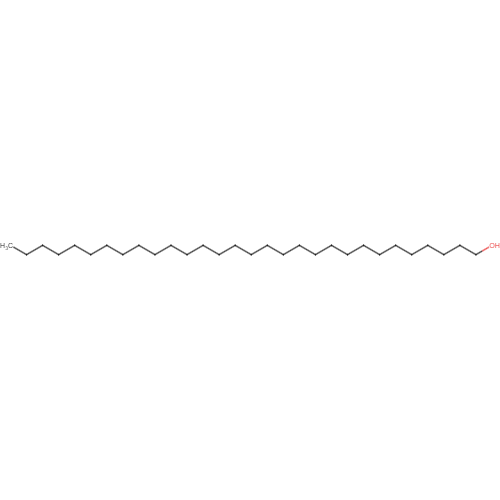1-Triacontanol
| Compound Structure: |

|
||||||||||||||||||||||||||||||||||||||||
|---|---|---|---|---|---|---|---|---|---|---|---|---|---|---|---|---|---|---|---|---|---|---|---|---|---|---|---|---|---|---|---|---|---|---|---|---|---|---|---|---|---|
| Synonyms: | 1-Triacontanol;Triacontan-1-ol;593-50-0;Triacontanol;Myricyl alcohol;Melissyl alcohol;n-Triacontano;Triacontyl alcohol;Triacontanol-1;miraculan;1-Hydroxytriacontane | ||||||||||||||||||||||||||||||||||||||||
| Compound ID: | NMPC-131 | ||||||||||||||||||||||||||||||||||||||||
| PubChem ID: | |||||||||||||||||||||||||||||||||||||||||
| Molecular Formula: | C30H62O | ||||||||||||||||||||||||||||||||||||||||
| Canonical SMILES: | CCCCCCCCCCCCCCCCCCCCCCCCCCCCCCO | ||||||||||||||||||||||||||||||||||||||||
| InChIKey: | REZQBEBOWJAQKS-UHFFFAOYSA-N | ||||||||||||||||||||||||||||||||||||||||
| About the compound: | Triacontan-1-ol, also known as 1-triacontanol, is an ultra-long-chain primary fatty alcohol. It is derived from triacontane, with one of the terminal methyl hydrogens replaced by a hydroxy group, making it a fatty alcohol. This compound, 1-triacontanol, is naturally found in various organisms such as Haplophyllum bucharicum, Euphorbia dracunculoides, and others. It plays a significant role in plant growth regulation and has been widely used to enhance crop yields, particularly in Asia. 1-Triacontanol is known to stimulate plant growth through several mechanisms, including increasing photosynthesis rates, promoting protein biosynthesis, enhancing nutrient transport within the plant, and boosting enzyme activity. It also reduces complex carbohydrates and enhances the physiological efficiency of plant cells, ultimately leading to increased plant growth and productivity. It's important to note that while 1-triacontanol has a positive impact on the growth and yield of many crops, its effects can vary among different plant species. The optimal dosage of triacontanol may also vary, as excessive amounts can have adverse effects on plant growth. In some cases, the treatment with triacontanol has been shown to increase the productivity of plants with therapeutic properties. Additionally, triacontanol has been observed to influence opium and morphine production in certain plants. GHS Hazard Statements Not Classified Reported as not meeting GHS hazard criteria by 3 of 3 companies. For more detailed information, please visit ECHA C&L website. |
||||||||||||||||||||||||||||||||||||||||
| Properties: |
Chemical and Physical Properties
Source:
PubChem |
||||||||||||||||||||||||||||||||||||||||
| Source Species: |
Setaria megaphylla |